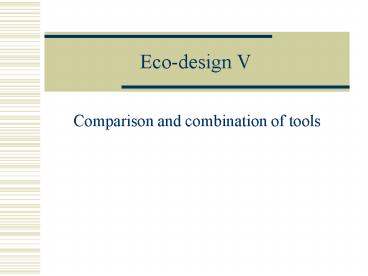Ecodesign V - PowerPoint PPT Presentation
1 / 26
Title:
Ecodesign V
Description:
... of the study. Data collection about technical processes, and data analysis information about ... Which academic societies are concerned with the tool? Formal ... – PowerPoint PPT presentation
Number of Views:59
Avg rating:3.0/5.0
Title: Ecodesign V
1
Eco-design V
- Comparison and combination of tools
2
1. User characteristics
3
Framework for tool description
4
Goal and scope
- Environmental approach LCA, MFA, env. IOA
- Monetised approach
- Integrated approach requires combination of tools
5
Types of application
- Environmental Management System
- Environmental Audit
- Environmental Performance Evaluation
- Environmental labelling
- Eco-design
- Environmental Impact Assessment
- Green procurement
- Voluntary agreements
- Quality management system
- Total Quality Environmental Management
6
2. Technical charcteristics
7
(No Transcript)
8
Object of analysis
- Substances ERA, SFA
- Materials MFA
- Products/services LCA, MIPS, CERA, matrices,
checklists, env. IOA, LCC - Processes LCC
- Technologies TCA
- Projects / activities CBA, LCC, TCA
9
System definition
10
Modes of analysis how the analysis is to be
performed?
- Descriptive vs. change-oriented mode
- Fixed-coefficient (black box) vs. variable
coefficient (behavioral) mode - Simplified vs. detailed mode
- Static vs. steady state vs. dynamic mode
- Full mode (selects processes on a yes/no basis)
vs. attribution mode (includes processes in the
extent to which they are linked to a given
function, demand or external decision)
11
Spatial characteristics
- Non-site specific tools operate in global or
regional scale LCA, MIPS, MFA, CERA, checklists,
matrices, env. IOA, LCC, - Site specific tools operate on a regional or
local scale ERA, TCA, CBA
12
Temporal characteristics
- descriptive-static models CERA, checklists,
matrices, env. IOA, LCC, CBA - comparative-static equilibrium steady state
models LCA, MIPS, ERA, TCA - dynamic models MFA
13
Methodological steps
LCA
- System definition ? goal and scope of the study
- Data collection about technical processes, and
data analysis ? information about environmental
interventions - Impact assessment ? environmental effects related
to the interventions - Interpretation
MFA CERA Env. IOA
MIPS Matrices Checklists LCC TCA CBA
ERA
14
Types of environmental interventions
- Toxic emissions ERA
- primary energy carriers CERA
- Inputs MIPS, MFA
- Extractions, emissions LCA, env. IOA
- All environmental, social and economic impacts
LCC, TCA, CBA
15
Position in cause-effect chain
- Modelling of environmental processes can be
performed in the position of - Environmental intervention extractions,
emissions, land use MIPS, MFA, CERA, env. IOA - Environmental policy (midpoints) climate change,
acidification LCA - Damage (endpoints) human health (Years of Life
Lost, YLL Disability Adjusted Life Years,
DALYs), biodiversity LCC, CBA
16
Evaluation
- Evaluation combining the results on different
environmental issues - Missing ERA, CERA
- Weighting LCA, SFA
- Expert panel
17
Level of detail
- Generalised tools include processes and impacts
whereever they occur LCA, MIPS, CERA - Detailed tools include regionalisation MFA, SFA
- Very detailed tools ERA
18
Type of data
- Greater detail ? higher data need
19
Safeguard subjects
- Human health most tools
- Ecosystems most tools
- Natural resources CERA
- Costs TCA
20
3. Suitability of tools
21
4. Other characteristics of eco-design tools
22
Formal recognition
- ISO LCA
- UNEP LCA
- OECD ERA
- EU ERA
- US EPA ERA
- Several governments CBA
23
5. Combination of tools
24
Reasons for combinations
- Avoiding problem shifting
- Compensation of tools weaknesses
25
Criteria for combinations
- Complexity of evaluation. First efficient
screening of potential environmental effects
MIPS, MFA, CERA. Detailed and complex
evaluations LCA, SFA, ERA - Spatial specification. Site specific tools (ERA,
TCA, CBA) may be combined with non-site-specific
analysis (MIPS, MFA, CERA, LCA, SFA - Interventions and impact types. Tools that focus
on input-related interventions (MFA, MIPS) may be
combined with tools that focus on output-related
interventions (ERA) - User preferences may be either results in
monetary values (TCA, LCC, CBA) or in physical
values (LCA, MIPS, ERA, MFA, SFA, CERA)
26
Three types of combined or sequential use of tools
- Overlapping tools the type of system definition
for the tools is identical - Tools used in consequtive steps different tools
provide answers to different questions after each
other - Tools used in parallel to highligt different
aspects (environmental, economic) of the same
question































